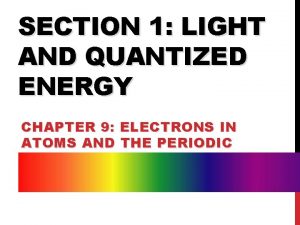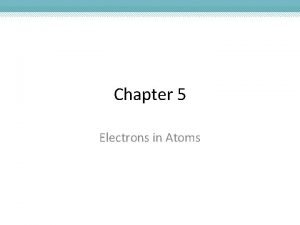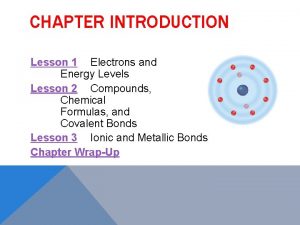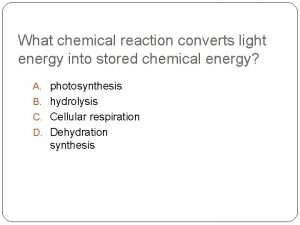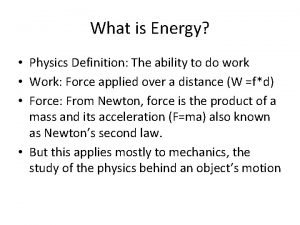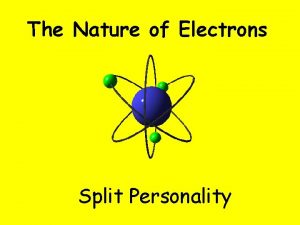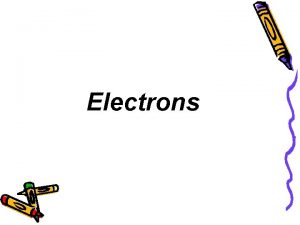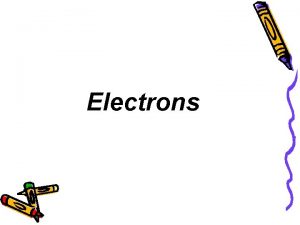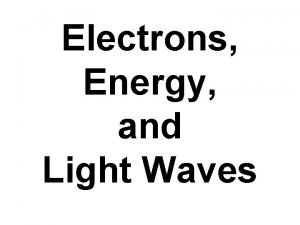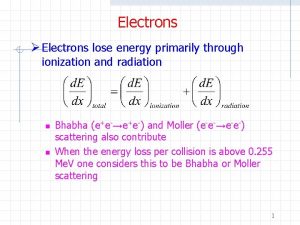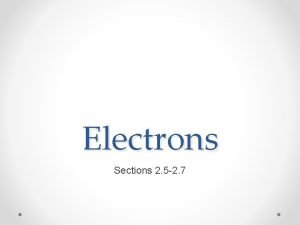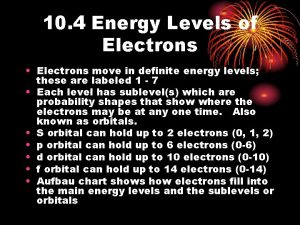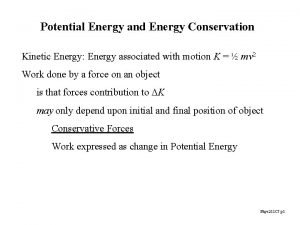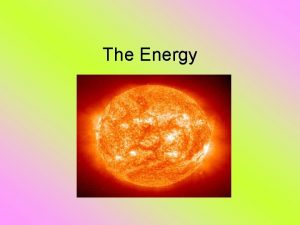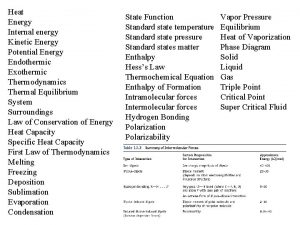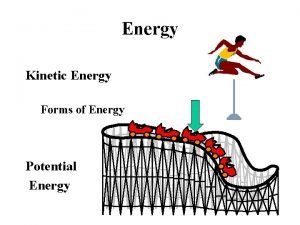Energy and Electrons Electrons n What are electrons








































- Slides: 40

Energy and Electrons

Electrons n What are electrons?

Electron Configuration n Electron configuration is the arrangement of electrons in an atom, molecule or other body. n The electrons occupy specific probability regions (known as orbitals), whose shapes and electron capacity vary.

Electron States n n n The lowest energy level that an electron can exist in is the ground state (n=1, 2, … 7). Higher energy levels are called excited states (n>1). In a given orbital, an electron that never radiates or absorbs energy is said to be in a stationary state.

Energy as Light n n n If an atom absorbs exactly the right amount of energy, the electron will rise to the next orbital or energy level. If an atom released an exact amount of energy, it would fall to a lower orbital or energy level. The energy released appeared as a photon of light.

Where are the electrons? n According to the Bohr model, electrons are found in energy levels around the nucleus. ¡ ¡ There are 7 different energy levels The farther the energy level is from the nucleus, the greater the amount of energy it holds.

To Summarize. . .

For example. . . n Calculate the number and types of sublevels, the total number of orbitals, and the maximum number of electrons with an energy level of 6 ¡ ¡ n=6 types of orbitals = n = 6 there are n 2 orbitals on level 6 = 36 there are 2 n 2 electrons = maximum 72 electrons

Which state do you live in? n n n For each element, the atomic number = number of protons = number of electrons The electron configuration must equal the number of protons in the atom and advance by 2 n 2 Advance by 2 electrons, 4, 9, 16, etc.

Electron Behavior n An electron can orbit in specified energy levels (orbitals). The further the orbital from the nucleus, the greater the energy level. ¡ Orbital: a region in an atom where there is a high probability of finding electrons

How many can fit? n Each level can hold a specific number of electrons ¡ ¡ ¡ n = the energy level 2 n 2 = the maximum number of electrons that energy level can hold So, the first energy level can hold n 2 x 12 = 2 electrons

Draw a Bohr Atom: Ground State Configuration n Put all of the protons in the nucleus ¡ n Determine the number of electrons in the atom ¡ n p+ e- = p + Add your electrons to each energy level completely filling one level before moving to the next highest level. ¡ Remember the max is 2 n 2 electrons in each level

Bohr-ing Electrons! n Atomic Number = 13 13 p+ 2 e- 8 e- 3 e- For a total of 13 electrons

You practice a few n Draw the ground-state electron configuration for ¡ ¡ Oxygen Potassium

Oxygen n n Atomic Number (# electrons) = 8 Maximum # electrons = 8 = 2 n 2 Level & Types of orbitals = n = 2 Number of orbitals = n 2 = 4 Fill the electron orbitals like this: ¡ 2+6

Potassium n n n Atomic Number (# electrons) = 19 n = 3. 08 = 3 Fill the orbitals 2 + 8 + 9

Classwork n Draw the Bohr electron diagrams for the 1 st 20 elements

Quantum Numbers n n To define the region in which electrons can be found, there are 4 quantum numbers assigned Quantum number: a number that specifies the properties of electrons

The principal of it all n n n The principal quantum number, n, indicates the main energy level occupied by the electron The values for n are in positive whole integers (1, 2, 3, 4) As n increases, the distance from the nucleus increases

Next comes the l n n n The angular momentum quantum number, l, indicates the shape of the orbital If l = 0, then there is an s orbital If l = 1, p orbital If l = 2, d orbital If l = 3, f orbital

Okay, now with the m n n n Next comes the magnetic quantum number, m, which is a subset of the l quantum number This number indicates the numbers and orientations of the orbitals The number of orbitals include 1 s, 3 p, 5 d and 7 f orbitals.

Last, but not least, n The spin quantum number, +1/2 or -1/2 ( ), indicates the orientation of the electron’s magnetic field relative to an outside magnetic field

Orbitals n n Each orbital is associated with a different letter: s, p, d, f, g, . . . As chemists, we will only look at the s, p, d and f orbitals Each orbital can accommodate only 2 electrons with opposite spins Empty, half-filled and filled orbitals contain 0, 1 and 2 electrons, respectively

Pauli Exclusion Principle n n The principle that states that two particles of a certain class cannot be in the exact same energy state. In other words, only 2 electrons can occupy a single orbital

Heisenburg Uncertainty Principle n You cannot know simultaneously ¡ ¡ Where an electron is, and How fast it is moving

S Orbitals n n There is only one type of s orbital and it is present on every principal energy level. The s orbital is spherical

The p Orbital n n n There are three types of p orbitals (px, py and pz) p orbitals are on every energy level except level 1 All p orbitals have a dumbell shape

The d Orbitals n There are 5 types of d orbitals and they are located on every energy level except for level 1 and level 2

The f Orbitals n n There are 7 types of f orbitals and they are located on every energy level except for levels 1, 2 and 3 The shapes of the f orbitals are extremely complex

Aufbau Principle n n The principle that states that the structure of each successive element is obtained by adding one proton to the nucleus of the atom and one electron to the lowest energy orbital. In other words, the electrons must fill the lowest energy level available

The Diagonal Rule n n n The basic rule for assigning electrons to atoms is that electrons should occupy the lowest energy state possible. To determine the relative energies or sublevels, use the diagonal rule. Work from left and follow each arrow from tail to head and work from left to right.

Start-up: October 7 n What is an electron configuration?

The Chart 7 s 6 s 5 s 4 s 3 s 2 s 1 s 7 p 6 p 5 p 4 p 3 p 2 p 6 d 5 d 4 d 3 d 5 f 4 f

The Arrows 7 s 6 s 5 s 4 s 3 s 2 s 1 s 7 p 6 p 5 p 4 p 3 p 2 p 6 d 5 d 4 d 3 d Start Here 5 f 4 f

Write the electron filling pattern for the first 5 sublevels. Element H He Li Be B Atomic # 1 2 3 4 5 Electron Config. 1 s 1 1 s 22 s 22 p 1

Shortcut n n n In order to conserve space, we use shorthand When you reach a noble gas, the next element will begin a new principal energy level (He, Ne, Ar, Kr, Xe, Rn) Place the symbol in brackets in place of the configuration scheme before it

Sodium, for example n n Neon Atomic Number = 10 Electron Configuration: ¡ n n 1 s 2 2 p 6 Sodium Atomic Number = 11 Electron Configuration: ¡ [Ne] 3 s 1

Classwork n Write the electron configuration of Bromine using the diagonal rule and the “shorthand” notation ¡ ¡ 1 s 2 2 p 6 3 s 2 3 p 6 4 s 2 3 d 10 4 p 5 [Ar] 4 s 2 3 d 10 4 p 5 or [Ar] 3 d 10 4 s 2 4 p 5

Fun Facts n The orbital names s, p, d, and f stand for names given to groups of lines in the spectra of the alkali metals. These line groups are called sharp, principal, diffuse, and fundamental.

Homework n P. 99 numbers 1 - 11
 Insidan region jh
Insidan region jh Energy energy transfer and general energy analysis
Energy energy transfer and general energy analysis Energy energy transfer and general energy analysis
Energy energy transfer and general energy analysis Electrons in atoms section 1 light and quantized energy
Electrons in atoms section 1 light and quantized energy Electrons in atoms section 1 light and quantized energy
Electrons in atoms section 1 light and quantized energy Lesson 1 electrons and energy levels
Lesson 1 electrons and energy levels Lesson 1 electrons and energy levels
Lesson 1 electrons and energy levels Energy level sublevel orbital
Energy level sublevel orbital How many electrons are in the third energy level?
How many electrons are in the third energy level? High energy electrons
High energy electrons Section 1 work and machines section 2 describing energy
Section 1 work and machines section 2 describing energy Primary energy and secondary energy
Primary energy and secondary energy Disadvantages of conventional energy
Disadvantages of conventional energy Helmholtz free energy and gibbs free energy
Helmholtz free energy and gibbs free energy Renewable energy and energy efficiency partnership
Renewable energy and energy efficiency partnership Types of potential energy
Types of potential energy Conservation of mechanical energy
Conservation of mechanical energy Mechanical advantage
Mechanical advantage Potential energy units
Potential energy units Energy forms and energy conversions
Energy forms and energy conversions Site:slidetodoc.com
Site:slidetodoc.com Gibbs free energy equation
Gibbs free energy equation How to find free energy
How to find free energy How to increase potential energy
How to increase potential energy Thermal energy vs heat energy
Thermal energy vs heat energy A hairdryer converts ____ energy into ____ energy.
A hairdryer converts ____ energy into ____ energy. Power equation
Power equation How to convert mechanical energy to electrical energy
How to convert mechanical energy to electrical energy Chapter 5 thermal energy answer key
Chapter 5 thermal energy answer key Delta g = rt ln(q/k)
Delta g = rt ln(q/k) As nutritional energy passes through the food chain energy
As nutritional energy passes through the food chain energy Usable chemical energy in food begins as __________ energy.
Usable chemical energy in food begins as __________ energy. Chapter 7 energy conservation of energy
Chapter 7 energy conservation of energy Indirect forms of solar energy
Indirect forms of solar energy ________ converts light energy into chemical energy. *
________ converts light energy into chemical energy. * Gravitational potential energy store
Gravitational potential energy store Potential energy examples
Potential energy examples Electrostatic field formula
Electrostatic field formula Energyphysics
Energyphysics Mechanical energy example
Mechanical energy example Gravitational potential energy vs kinetic energy
Gravitational potential energy vs kinetic energy



